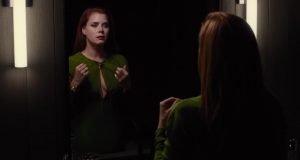![]()
If you’ve seen any advertising for the new film Nocturnal Animals you might think of it as a fairly typical thriller. In reality, this effort from director Tom Ford (A Single Man) isn’t as straight-forward as it might initially seem. This is a unique and beautifully shot feature that takes a well-worn idea (a failed relationship) and spins it in an unusual direction. The movie is certainly eccentric, but it is also compelling and should leave viewers thinking long after it ends.
 Susan Morrow (Amy Adams) runs a New York art gallery. She’s wealthy, successful and resides in the upper class, but feels emotionally lost. With a failing marriage, Susan now believes her life hasn’t gone the way she had hoped. In the mail, she receives a manuscript from her estranged ex-husband, Edward Sheffield (Jake Gyllenhaal). Dedicated to her, it’s a violent and disturbing tale that follows a husband (also played by Gyllenhaal) driving through the night with his wife (Isla Fisher) and daughter (Ellie Bamber). They’re terrorized by a group of predatory thugs, led by Ray (Arron Taylor-Johnson). As Susan continues reading the book, she remembers her time with Edward and the painful end of their marriage.
Susan Morrow (Amy Adams) runs a New York art gallery. She’s wealthy, successful and resides in the upper class, but feels emotionally lost. With a failing marriage, Susan now believes her life hasn’t gone the way she had hoped. In the mail, she receives a manuscript from her estranged ex-husband, Edward Sheffield (Jake Gyllenhaal). Dedicated to her, it’s a violent and disturbing tale that follows a husband (also played by Gyllenhaal) driving through the night with his wife (Isla Fisher) and daughter (Ellie Bamber). They’re terrorized by a group of predatory thugs, led by Ray (Arron Taylor-Johnson). As Susan continues reading the book, she remembers her time with Edward and the painful end of their marriage.
This psychological thriller subverts many viewer expectations, playing in different tonalities. While the depiction of the book’s story is emotional, upsetting and distressing to watch, it comes as a complete contrast to Susan’s current position and lifestyle. The look of the film is striking; there are different visual styles to the various sections that help differentiate them. Susan’s house and art gallery world look particularly icy, mirroring her own comments about the vapidity of her chosen life. All the while, the film’s other segments feature a different palate.
 The revenge novel is the movie’s most traditional aspect, but it’s artfully lensed and compelling to watch. Michael Shannon also adds a bit of humor to the grimness as a blunt detective on the case. The vicious tale works well in conjunction with other sections, creating even more unease and uncertainty. Viewers are never quite certain where things are going. In fact, as the possibility of the exes reuniting arrives, many will anticipate the film heading off on a completely different tangent that it ultimately does.
The revenge novel is the movie’s most traditional aspect, but it’s artfully lensed and compelling to watch. Michael Shannon also adds a bit of humor to the grimness as a blunt detective on the case. The vicious tale works well in conjunction with other sections, creating even more unease and uncertainty. Viewers are never quite certain where things are going. In fact, as the possibility of the exes reuniting arrives, many will anticipate the film heading off on a completely different tangent that it ultimately does.
Personally, a lot of interest and enjoyment in the film came from looking for the nods in the fictional story to the real relationship between Edward and Susan. In fact, this pair frequently discuss art, the act of creation and inspiration during their marriage. It’s very clear in watching that Edward has suffered greatly from the breakup; while the book doesn’t directly address this, one can definitely see symbolism and references to events in their life.
 And that’s why the story is largely gripping; of course, nothing is stated outright, yet you certainly get a sense of Edward’s pain in his creation and his feelings about Susan. It’s the type of film that one immediately wants to revisit in order to search for more telling behaviors and comments (some of which may even be represented in the story’s supporting characters).
And that’s why the story is largely gripping; of course, nothing is stated outright, yet you certainly get a sense of Edward’s pain in his creation and his feelings about Susan. It’s the type of film that one immediately wants to revisit in order to search for more telling behaviors and comments (some of which may even be represented in the story’s supporting characters).
And that is ultimately what the movie is all about. This is subtle stuff, open to interpretation and it offers no explicit exposition that tells you what it all ultimately means. But as the credits roll, you get a certain feeling about Edward and what he’s attempting to communicate to his ex-wife. Nocturnal Animals is an acquired taste, but it’s a very well-made, unique film with strong performances and interesting insight that ties a work of fiction to the inner state and emotions of its creator.


